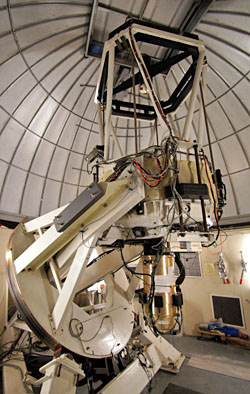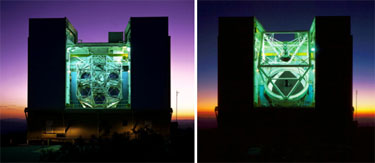| Dutch astronomy writer and S&T contributing editor Govert Schilling visits observatories in southern Arizona. |

The 4.3-foot (1.3-m) robotic telescope used to conduct part of the 2MASS infrared sky survey.
Govert Schilling
Along the way we encounter a couple of relatively small telescopes that sit close together along "the ridge." One is a robotic 1.3-m reflector used to create the northern part of the 2MASS infrared sky survey. These days it responds to alerts for transient phenomena like gamma-ray bursts. Neighboring small roboscopes hunt for transiting extrasolar planets, while the observatory's original 1.5-m reflector was used to create the first 3D-maps of the distribution of remote galaxies.
Still higher up is the MMT Observatory. I still recall my excitement when I first heard about the original project in the late 1970s: six 72-inch (1.8-m) mirrors on a single mount, gathering the same amount of light as one 4½-m mirror.
But in 2000, the sextet was replaced by a single mirror 21 feet (6.5 m) across. "Not because the original idea didn’t work," says Brocious, "but because this was a very cheap way of building a 6.5-m telescope — we already had the mount and the enclosure."

Left: The original Multiple-Mirror Telescope (MMT) on Mount Hopkins featured a unique clustering of six large mirrors on a single mount. Right: Today the MMT Observatory houses a single primary mirror with an aperture of 21.3 feet (6.5 m). Click here for a larger version.
Smithsonian Astrophysical Obs.
The new instrument is huge, and it snugly fits into the co-rotating building. It must have been a tortuous operation to transport the giant mirror up the unpaved mountain road. Then again, it didn’t have to move far: the mirror was cast, grounded and polished at the Steward Observatory’s Mirror Lab in downtown Tucson.
Tucked beneath the east wing of the open-air football stadium of the Arizona Wildcats, the Mirror Lab is the brainchild of Roger Angel, who pioneered the casting of giant, lightweight telescope mirrors in rotating ovens. But during my visit, the oven is empty — it's being prepared for the casting of the second 8.4-m mirror for the future Giant Magellan Telescope (GMT). Its twin is being meticulously tested. "If all goes well, we can start the final round of polishing within a few weeks," says lab scientist Buddy Martin.

The enormity of the Large Binocular Telescope is evident in this photo — which shows (right of center) only one of its twin 28-foot (8.4-m) primary mirrors. Click here for a larger version.
Govert Schilling
Two earlier 8.4-meter mirrors cast at the Mirror Lab are already in use at Mount Graham, which is 115 miles (185 km) east of Tucson in the Pinaleño Mountains. Together, they form the eyes of the Large Binocular Telescope (LBT). With the light-gathering power of a single glass eye 39 feet (11.8 m) across, the LBT is effectively the largest optical telescope in the world on a single mount.
LBT director Richard Green takes me on the 3½-hour trip from Tucson to Mount Graham's summit, home of an endangered (and controversial) red squirrel. I have seen the Keck telescopes at Mauna Kea, and the European Very Large Telescope in Chile, but the LBT is huge — incredibly huge. "The second adaptive secondary mirror will arrive later this year," Green comments. More instruments will be added too, but already half of the available nights are dedicated to real science.
On the way back, I realize that not even the Chilean Andes can boast so many professional observatories in so compact an area. Maybe Arizona's nickname, the "Grand Canyon State," should be changed to the "Astronomy State."
Part 1 of this blog, about the Catalina Sky Survey and Kitt Peak National Observatory, can be found here.
 1
1
Comments
Howard Lester
May 15, 2011 at 8:45 am
I am the photographer of the above two side by side photographs of the MMT Observatory. Both were taken with a large format 4x5 camera with Fuji Provia 100F film. The left photo was taken in October 1997 after the building shutters were replaced with larger ones. Larger ones were installed to accommodate the new optics support structure for the 6.5-meter telescope, f/1.25, which is the seen in the right-hand photo. That one was taken in October 2002.
Howard Lester, MMT Observatory
You must be logged in to post a comment.
You must be logged in to post a comment.